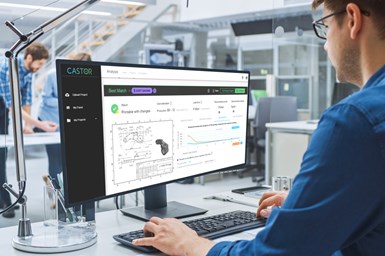Software Automatically Identifies Suitable Parts for 3D Printing Using 2D Drawings
The software is designed to automate the complex process which is required to manually analyze a large number of parts.
The software is designed to automate the complex process which is required to manually analyze a large number of parts. Photo Credit: Castor
Castor has developed a software that automatically identifies parts that are viable to consider for 3D printing, out of thousands of files, using a set of geometric and economic analyses. The company says this technology makes it possible to automatically identify parts for 3D printing using 2D drawings, even when 3D CAD files are not available.
This capability is said to solve a problem many companies face, particularly if they rely on 2D drawings that are decades old which may make it difficult and time-consuming to determine which of their parts could be 3D printed. The technology behind Castor’s 2D analysis is based on a computer vision that interprets the geometry and product manufacturing information (PMI) of each part; and machine learning models that have gained deeper insights and improved over time due to the number of parts that are uploaded to Castor on a daily basis.
The software is designed to automate the complex process which is required to manually analyze a large number of parts. The company says the software offers a feasible way for companies to assess the compatibility of additive manufacturing (AM) by automatically analyzing their design files to gain valuable data and knowledge regarding the potential of AM for them. It is said this tool can help users find new business cases and discover opportunities to reach their initiatives and 3D printing goals using their existing 2D design files.
This analysis is well suited for tackling legacy products or building an AM spare parts program, the company says. The software enables users to upload thousands of parts from 2D drawings at once. Once parts are uploaded, the software automatically extracts PMI out of PDF files of 2D Drawings and calculates parts’ size, volume, complexity and more based on dimensions from projected views. It then suggests 3D printability of parts, recommends optimal technology and materials and performs a financial analysis of AM compared to traditional manufacturing. It also exports useful information and insights, both as a formal PDF report and a raw data excel sheet.
Related Content
-
Copper, New Metal Printing Processes, Upgrades Based on Software and More from Formnext 2023: AM Radio #46
Formnext 2023 showed that additive manufacturing may be maturing, but it is certainly not stagnant. In this episode, we dive into observations around technology enhancements, new processes and materials, robots, sustainability and more trends from the show.
-
Chuck Jaws Achieve 77% Weight Reduction Through 3D Printing
Alpha Precision Group (APG) has developed an innovative workholding design for faster spindle speeds through sinter-based additive manufacturing.
-
How Avid Product Development Creates Efficiencies in High-Mix, Low-Volume Additive Manufacturing
Contract manufacturer Avid Product Development (a Lubrizol company) has developed strategies to streamline part production through 3D printing so its engineering team can focus on development, design, assembly and other services.












